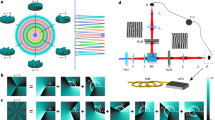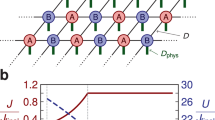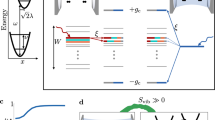Abstract
Experimental observations are usually described using theoretical models that make assumptions about the dimensionality of the system under consideration. However, would it be possible to assess the dimension of a completely unknown system only from the results of measurements performed on it, without any extra assumption? The concept of a dimension witness1,2,3,4,5,6 answers this question, as it allows bounding the dimension of an unknown system only from measurement statistics. Here, we report on the experimental demonstration of dimension witnesses in a prepare and measure scenario6. We use photon pairs entangled in polarization and orbital angular momentum 7,8,9 to generate ensembles of classical and quantum states of dimensions up to 4. We then use a dimension witness to certify their dimensionality as well as their quantum nature. Our work opens new avenues in quantum information science, where dimension represents a powerful resource10,11,12, especially for device-independent estimation of quantum systems13,14,15,16 and quantum communications17,18.
This is a preview of subscription content, access via your institution
Access options
Subscribe to this journal
Receive 12 print issues and online access
$259.00 per year
only $21.58 per issue
Buy this article
- Purchase on SpringerLink
- Instant access to full article PDF
Prices may be subject to local taxes which are calculated during checkout



Similar content being viewed by others
References
Brunner, N., Pironio, S., Acín, A., Gisin, N., Méthot, A. & Scarani, V. Testing the dimension of Hilbert spaces. Phys. Rev. Lett. 100, 210503 (2008).
Pál, K. & Vértesi, T. Efficiency of higher-dimensional Hilbert spaces for the violation of Bell inequalities. Phys. Rev. A 77, 042105 (2008).
Pérez-García, D., Wolf, M. M., Palazuelos, C., Villanueva, I. & Junge, M. Unbounded violation of tripartite Bell inequalities. Commun. Math. Phys. 279, 455–486 (2008).
Wehner, S., Christandl, M. & Doherty, A. C. Lower bound on the dimension of a quantum system given measured data. Phys. Rev. A 78, 062112 (2008).
Wolf, M. M. & Pérez-García, D. Assessing quantum dimensionality from observable dynamics. Phys. Rev. Lett. 102, 190504 (2009).
Gallego, R., Brunner, N., Hadley, C. & Acín, A. Device-independent tests of classical and quantum dimensions. Phys. Rev. Lett. 105, 230501 (2010).
Molina-Terriza, G., Torres, J. P. & Torner, L. Twisted photons. Nature Phys. 3, 305–310 (2007).
Mair, A., Vaziri, A., Weihs, G. & Zeilinger, A. Entanglement of the orbital angular momentum states of photons. Nature 412, 313–316 (2001).
Dada, A. C., Leach, J., Buller, G. S., Padgett, M. J. & Andersson, E. Experimental high-dimensional two-photon entanglement and violations of generalized Bell inequalities. Nature Phys. 7, 677–680 (2011).
Lanyon, B. et al. Simplifying quantum logic using higher-dimensional Hilbert spaces. Nature Phys. 5, 134–140 (2009).
Spekkens, R. W. & Rudolph, T. Degrees of concealment and bindingness in quantum bit commitment protocols. Phys. Rev. A 65, 012310 (2001).
Acín, A., Gisin, N. & Masanes, Ll. From Bell’s theorem to secure quantum key distribution. Phys. Rev. Lett. 97, 120405 (2006).
Mayers, D. & Yao, A. Self testing quantum apparatus. Quant. Inf. Comp. 4, 273–286 (2004).
Bardyn, C.-E., Liew, T. C. H., Massar, S., McKague, M. & Scarani, V. Device-independent state estimation based on Bell’s inequalities. Phys. Rev. A 80, 062327 (2009).
Bancal, J-D., Gisin, N., Liang, Y-C. & Pironio, S. Device-independent witnesses of genuine multipartite entanglement. Phys. Rev. Lett. 106, 250404 (2011).
Rabelo, R., Ho, M., Cavalcanti, D., Brunner, N. & Scarani, V. Device-independent certification of entangled measurements. Phys. Rev. Lett. 107, 050502 (2011).
Pawlowski, M. & Brunner, N. Semi-device-independent security of one-way quantum key distribution. Phys. Rev. A 84, 010302 (2011).
Li, H-W. et al. Semi-device-independent random-number expansion without entanglement. Phys. Rev. A 84, 034301 (2011).
Langford, N. K. et al. Measuring entangled qutrits and their use for quantum bit commitment. Phys. Rev. Lett. 93, 053601 (2004).
Molina-Terriza, G., Vaziri, A., Ursin, R. & Zeilinger, A. Experimental Quantum Coin Tossing. Phys. Rev. Lett. 94, 040501 (2005).
Massar, S. Nonlocality, closing the detection loophole, and communication complexity. Phys. Rev. A 65, 032121 (2002).
Vértesi, T., Pironio, S. & Brunner, N. Closing the detection loophole in bell experiments using qudits. Phys. Rev. Lett. 104, 060401 (2010).
Vértesi, T. & Pál, K. Generalized Clauser-Horne-Shimony-Holt inequalities maximally violated by higher-dimensional systems. Phys. Rev. A 77, 042106 (2008).
Junge, M., Palazuelos, C., Pérez-García, D., Villanueva, I. & Wolf, M. M. Operator space theory: A natural framework for bell inequalities. Phys. Rev. Lett. 104, 170405 (2010).
Briët, J., Buhrman, H. & Toner, B. A generalized Grothendieck inequality and nonlocal correlations that require high entanglement. Commun. Math. Phys. 305, 827–843 (2011).
Junge, M. & Palazuelos, C. Large violation of Bell inequalities with low entanglement. Commun. Math. Phys. 306, 695–746 (2011).
Molina-Terriza, G., Torres, J. P. & Torner, L. Management of the orbital angular momentum of light: Preparation of photons in multidimensional vector states of angular momentum. Phys. Rev. Lett. 88, 013601 (2002).
Allen, L., Beijersbergen, M. W., Spreeuw, R. J. C. & Woerdman, J. P. Orbital angular momentum of light and the transformation of Laguerre–Gaussian laser modes. Phys. Rev. A 45, 8185–8189 (1992).
Acknowledgements
We thank C. Hadley and E. Nagali for contributions in early stages of this work. We acknowledge support from the ERC Starting Grant PERCENT, the EU Projects Q-Essence, QCS and PHORBITECH (FET OPEN grant number 255914), the UK EPSRC, the Project MSM6198959213 of the Czech Ministry of Education, the Spanish projects FIS2010-14830, FIS2010-14831 and Chist-Era DIQIP, an FI Grant of the Generalitat de Catalunya, CatalunyaCaixa, and Fundació Privada Cellex, Barcelona.
Author information
Authors and Affiliations
Contributions
R.G., N.B. and A.A. developed the theory, M.H., R.G., N.B., A.A. and J.P.T. designed the experiment, and M.H., M.M. and J.P.T. performed the experiment. All of the authors contributed to the writing of the manuscript.
Corresponding authors
Ethics declarations
Competing interests
The authors declare no competing financial interests.
Supplementary information
Supplementary Information
Supplementary Information (PDF 473 kb)
Rights and permissions
About this article
Cite this article
Hendrych, M., Gallego, R., Mičuda, M. et al. Experimental estimation of the dimension of classical and quantum systems. Nature Phys 8, 588–591 (2012). https://doi.org/10.1038/nphys2334
Received:
Accepted:
Published:
Issue date:
DOI: https://doi.org/10.1038/nphys2334
This article is cited by
-
Certification of qubits in the prepare-and-measure scenario with large input alphabet and connections with the Grothendieck constant
Scientific Reports (2023)
-
Experimental entanglement quantification for unknown quantum states in a semi-device-independent manner
Science China Information Sciences (2023)
-
Entanglement-assisted quantum communication with simple measurements
Nature Communications (2022)
-
Near and mid-infrared optical vortex parametric oscillator based on KTA
Scientific Reports (2021)
-
Dimensionality distinguishers
Quantum Information Processing (2019)



